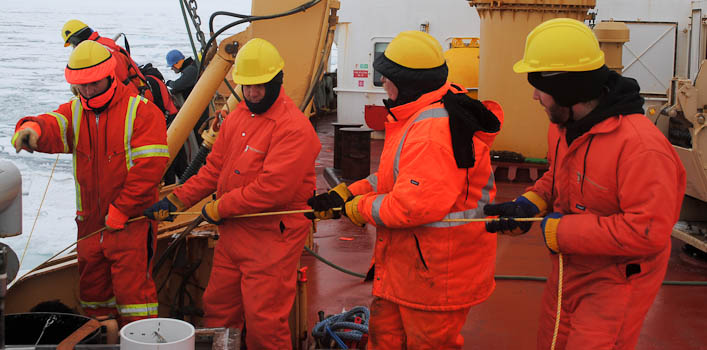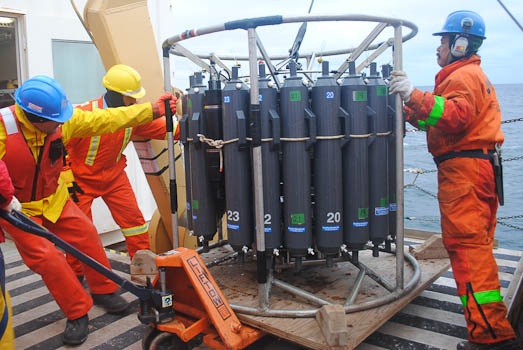Alex KainOctober 4, 2009Ask most people about their work and they will describe an environment of fluorescent lighting, paste-colored cubicles, and incessant telephone ringing. They will recount days in front of computer screens, endless email chains, typing, and confinement to desk chairs. This is the sedentary work of the professional managerial class, occupations that are defined by the transmission of ideas and typified by little movement away from a desk. The average American worker takes only five thousand steps a day, covering less than a mile in distance. People working jobs that require more stationary time behind a computer take even fewer. Work on an oceanographic research vessel, on the other hand, demands physical activity. Sailors and scientists rarely sit still on the job. Among other tasks, they operate cranes, transfer seawater samples from Niskin bottles to storage flasks, prepare the ship's food, and maintain the enormous engines that propel the ship through the ice and water. Each responsibility requires skill that unites physical movement with ideas, body with mind.
"This whole ship is about working with your hands," says Cadet Scott Mabee. Cadets like Mabee enroll in the Coast Guard College in Sidney, Nova Scotia, where their time on ships complements intense academic study. Cadet Ryan Gurr enrolled in the Coast Guard College after studying history and political science at the University of Western Ontario. Explaining his change in life path, Gurr says, "I saw myself heading toward a commute, a desk, and spending my entire day staring at a wall." But his experience in the Coast Guard, Gurr says, has brought him "open vistas" and the chance to perform physical labor that allows him to feel like he's making a difference. Though Gurr took pride in his academic work, it often translated into just a grade outside of any larger purpose. With the deployment and recovery of scientific gear, however, the results contribute to a noble goal and "become apparent faster," he says. Field research allows scientists to explore new places and see new environments, says Dan Carlson, a Ph.D. student at the University of Alaska-Fairbanks. Carlson designs and constructs research buoys as part of his graduate work. "When you build something, it's tangible. You can see it, touch it," he says. Carlson acknowledges that the end goal of most academic work is writing and publishing papers, but says that comes with "a different sense of accomplishment."
Of course, all jobs have their tedium and clerical work. On the ship, some technicians have to wait for two hours in the freezing cold to monitor a line winding up around a winch's spool. Others must put their graduate degrees to use by cleaning hundreds of test tubes or entering thousands of data points into a spreadsheet. Though, more often than not, these tasks constitute part of a job, not the essence of it. The short-term rewards and measurable success of physical labor come with a sense of gratification. On the Louis, that collective satisfaction fosters a congenial atmosphere where the norm is to feel fulfilled and happy. Regarding his change from office to ocean, Gurr says, "I feel satisfied. I'm excited every day I wake up and go to work." All text and photos property of Alex Kain. Last updated: October 7, 2019 | |||||||||||||||
Copyright ©2007 Woods Hole Oceanographic Institution, All Rights Reserved, Privacy Policy. | |||||||||||||||




